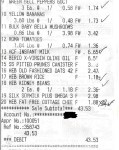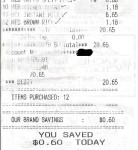As part of my training to become a registered dietitian nutritionist, I was required to attempt the Food Stamp Challenge. For five days, I was allowed $21.90 to spend on all food for all meals and snacks.
At the time of the assignment, $22.50 was the actual amount you would get on food stamps for that time period. Currently, the USDA thinks you can get by on $189/month as a household of 1, which translates to $31.50 for 5 days, if I were to do this assignment now.
To do the assignment, I assessed what I was currently eating in terms of calories and protein and figured out what I would need to go for if I made a meal plan with other foods. If you are interested in this data, I can email it to you for a nominal fee of $20, as I did it the old fashioned way: food log + nutritiondata.self.com + Excel. Considering that I am a single man who lives alone, eating similar foods every day, this is pretty much human experiment data.
The first thing I learned was that I was eating between 3200-4000 calories a day as a very active person and not-so-strict lacto-vegetarian (cheap food for grad school, but it was not my philosophy on life when eating out). Buying this many calories was going to be a challenge, as I did not want to lose hard-earned muscle mass or feel lethargic while at my internship. My preceptors can vouch that I actually did this.
I spent a good hour and a half at the grocery store weighing out the cheapest fruits and vegetables to meet needed servings of fruits and vegetables based on nutrient needs such as vitamin C and vitamin A. I learned that broccoli was one of the more expensive vegetables.
I went to the bulk food aisle and filled up on salted peanuts and salted sunflower seeds. Other foods I bought were a white onion, green bell peppers, small peaches, bulk carrots, small limes, jalapeño peppers, dried split peas, dried kidney beans, brown rice, and non-fat dry milk from the cooking aisle. My total bill was $20.65.
I cooked all the food on Sunday: pressure cooked the beans, peas, and rice separately. When finished, I weighed the products so I could calculate how much of a serving I could give myself to spread the food out over the 5 days into regular meals and snacks. I also dispensed the fruit and vegetables into similar servings. The salted peanuts and sunflower seeds were definitely the best part in terms of flavor.
The food was incredibly bland because I did not purchase seasonings on my budget. Even with buying high calorie, nutritious foods, I was only getting 2970 Calories per day. I did not sign up to lose weight on this assignment, so…I cheated a bit by adding oats (another cheap food I didn’t buy but already had) and spices to the food. I also slipped in some chocolate soymilk after a workout.
Maybe if I didn’t continue to workout, I could have found the calories on this diet sufficient for that period of time and wouldn’t have had to cheat. From a taste perspective though, I had to. It was so bland.
The assignment taught me how difficult it is to follow a meal plan. Even if it is well constructed, you cannot predict how well you will like the foods on it, whether you will be hungry or full, etc. I also learned that the capsaicin in jalapeños does not cook away as fast when cooking in water vs oil…I sweated that meal out!
I also learned what foods are cheap and nutritious. I did not buy organic and, when putting my meals into choosemyplate.gov, I was doing well meeting my quotas for micronutrients, not just carbohydrates, fat, protein, and total calories. The distribution of the macronutrients was also acceptable.
Foods I thought would be hard to afford on food stamps while having high calorie needs and still wanting to eat healthy included: organic foods, oils like olive oil and canola oil, packaged foods, broccoli, and fresh milk. Dry milk was my most expensive purchase. It doesn’t spoil and was slightly cheaper than fresh milk at the time. Last I checked it is about the same as fresh in the current market, unfortunately. At least it doesn’t spoil as fast.
Of course, the supplemental nutrition assistance program (SNAP), formerly called food stamps, is supposed to be supplemental. You also aren’t allowed to buy a multivitamin on it. In real life, you would not be limited to $21.90 and could afford to purchase spices, cooking oils, and other things that make food taste better. You also probably wouldn’t break your budget doing so.
Ever since attempting the Food Stamp Challenge, I have viewed eating out at restaurants and food stands as a social luxury. Yea, it is convenient and fun, but financially you are paying not only for the food but for the experience of eating out, the employees’ wages, the manager’s salary, overhead, supplies, etc. You also are paying to not be in control of your portion sizes and ingredients, but that’s another topic!
The point of this post is not to encourage anyone who doesn’t need to eat on food stamps to go try; rather, the point is to counter the idea that eating healthy is expensive or that the meal plans to be fit and active are expensive. I was still meeting my nutrition needs with adequate protein and calories for a fit and active person.
Share on

